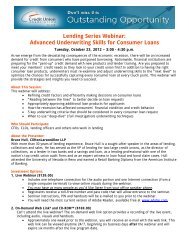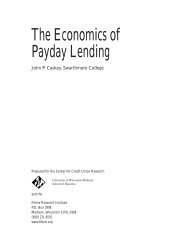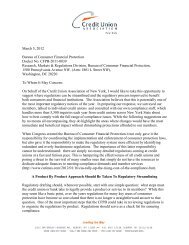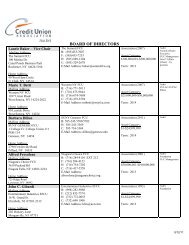Published by the Credit Union Association of New York
Published by the Credit Union Association of New York
Published by the Credit Union Association of New York
You also want an ePaper? Increase the reach of your titles
YUMPU automatically turns print PDFs into web optimized ePapers that Google loves.
alancesheetsolutions<br />
Boardroom excellence: The importance <strong>of</strong><br />
financial literacy training<br />
By Kristina Muller, CFA, Senior Portfolio Manager, Balance Sheet Solutions, LLC<br />
WWE ASK A LOT FROM OUR BOARD MEMBERS. VOLUNTEERING<br />
<strong>the</strong>ir time and efforts to help run a successful institution seems<br />
like enough to ask <strong>of</strong> <strong>the</strong>m. On top <strong>of</strong> that, regulations require<br />
that <strong>the</strong>y also receive regular training in many areas <strong>of</strong> <strong>the</strong><br />
credit union’s business and finances. Finding time to squeeze<br />
this training into already tight board meetings can be difficult.<br />
However, <strong>the</strong> importance <strong>of</strong> board training cannot be<br />
overemphasized. Your board <strong>of</strong> directors is ultimately<br />
responsible for <strong>the</strong> financial stability <strong>of</strong> your credit union.<br />
Therefore, it is important to work with a knowledgeable<br />
board that understands <strong>the</strong> risks that <strong>the</strong><br />
credit union faces. In Rule 701.4, <strong>the</strong><br />
NCUA focused on directors’ knowledge<br />
<strong>of</strong> financial statements, but board<br />
members need to be well informed about<br />
several o<strong>the</strong>r topics, as well. Let’s look at<br />
<strong>the</strong> importance <strong>of</strong> two specific training<br />
areas: asset liability management and<br />
investments.<br />
Asset liability management<br />
Asset liability management (ALM)<br />
paints a picture <strong>of</strong> <strong>the</strong> potential risks for your credit union,<br />
should <strong>the</strong> financial environment change. To assess <strong>the</strong>se risks,<br />
your balance sheet is run through a computer model that<br />
estimates changes that will occur both in static and in<br />
“shocked” interest rate scenarios. This modeling run is done<br />
on a regular basis, and <strong>the</strong> results should be presented to <strong>the</strong><br />
board for review. However, <strong>the</strong> terminology and modeling<br />
process <strong>of</strong> ALM is not something we use in everyday life, so<br />
<strong>the</strong> board may be unfamiliar with <strong>the</strong> concepts presented. In<br />
my experience, one training session is usually not enough to<br />
get someone up to speed on ALM concepts. It can take several<br />
quarters <strong>of</strong> exposure to ALM reports and terminology before<br />
a director feels comfortable with <strong>the</strong> material.<br />
In all financial market environments, boards need to<br />
understand <strong>the</strong> interest rate risks that credit unions are currently<br />
facing. Whe<strong>the</strong>r it is continued margin compression due to a<br />
low rate environment or a drop in asset value due to rising<br />
Boards need to<br />
understand <strong>the</strong><br />
interest rate risks.<br />
rates, if a director views an ALM report, <strong>the</strong>y need to understand<br />
<strong>the</strong> information in front <strong>of</strong> <strong>the</strong>m. Should problems develop<br />
down <strong>the</strong> road, <strong>the</strong> board cannot claim ignorance. The<br />
information (and potential risk) was presented to <strong>the</strong>m in <strong>the</strong><br />
ALM reports.<br />
A regular review <strong>of</strong> ALM terminology and concepts is <strong>the</strong><br />
key to getting board members familiar with <strong>the</strong>se reports. It<br />
is not uncommon to see a board member using a one-page<br />
“cheat sheet” along with <strong>the</strong>ir quarterly ALM report. This<br />
cheat sheet has <strong>the</strong> definition <strong>of</strong> <strong>the</strong> key metrics <strong>the</strong>y are<br />
reviewing and <strong>the</strong> ranges for each metric<br />
to be in compliance with <strong>the</strong>ir credit union’s<br />
risk management policy. Webinars on <strong>the</strong><br />
topic <strong>of</strong> ALM can also be broadcast at<br />
board meetings to help build familiarity<br />
with <strong>the</strong> reports. If <strong>the</strong> board has not had<br />
ALM training in quite some time and a<br />
more intense approach is needed, many<br />
ALM providers can <strong>of</strong>fer an on-site<br />
training session that focuses specifically<br />
on your credit union’s ALM pr<strong>of</strong>ile.<br />
Investments<br />
Investments may be an easier concept for <strong>the</strong> board to<br />
understand than ALM, but <strong>the</strong> key here is for <strong>the</strong> board to<br />
recognize how <strong>the</strong> investments impact <strong>the</strong> balance sheet. A<br />
callable bond may <strong>of</strong>fer a higher yield than a non-callable<br />
bond, but that call option adds risk to <strong>the</strong> balance sheet that<br />
<strong>the</strong> credit union may not need.<br />
In addition to investment concepts, <strong>the</strong> board needs to<br />
become familiar with <strong>the</strong> current market environment. We all<br />
know that yields are low right now, but is your board actually<br />
aware <strong>of</strong> how low? Would board members be surprised if you<br />
mentioned that you bought a five-year bond and only received<br />
a yield <strong>of</strong> 1.20 percent? What type <strong>of</strong> risk does this add to <strong>the</strong><br />
balance sheet? Board members need to understand that investing<br />
for an institution is different than managing <strong>the</strong>ir own personal<br />
investment portfolio. Each credit union investment plays a<br />
role in impacting <strong>the</strong> balance sheet.<br />
36 SEPTEMBER 2012 Connection






